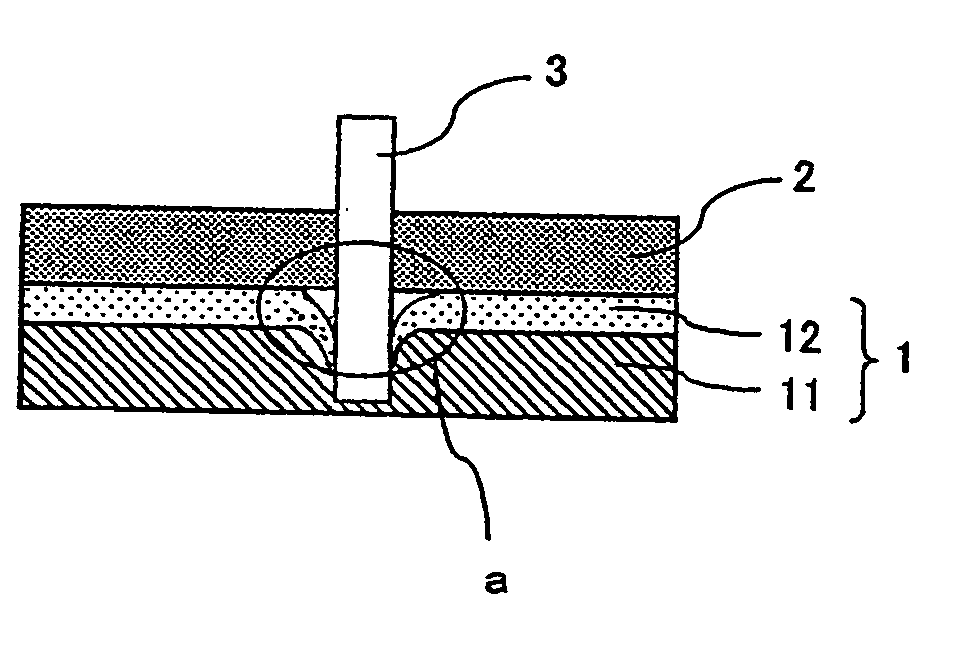Dicing adhesive sheet and dicing method
a technology of adhesive sheet and dicing method, which is applied in the direction of film/foil adhesives, chemistry apparatus and processes, transportation and packaging, etc., can solve the problem of insufficient adhesion, and achieve the effect of effectively suppressing or preventing the cracking
- Summary
- Abstract
- Description
- Claims
- Application Information
AI Technical Summary
Benefits of technology
Problems solved by technology
Method used
Image
Examples
example 1
[0041] Base Film
[0042] The base film used was a linear low density polyethylene film with a thickness of 70 μm. One side of the film was corona treated.
[0043] Preparation of Adhesive
[0044] A solution of a radiation-curable acrylic adhesive was produced by adding 60 parts by weight of a radiation-curable oligomer (with a viscosity of 10 Pa·sec at 25° C.), 3 parts by weight of a photopolymerization initiator (Irgacure 651 (trade name) manufactured by Chiba Specialty Chemicals) and 2 parts by weight of a polyisocyanate compound (Coronate L (trade name) manufacture by Nippon Polyurethane Industry Co., Ltd.) to a solution containing an acrylic copolymer with a weight average molecular weight of 800,000. The radiation-curable oligomer was a product of the reaction of pentaerythritol triacrylate and diisocyanate. The acrylic copolymer was a product of conventional polymerization of 60 parts by weight of methyl acrylate (which can form a homopolymer with a Tg of 8° C.), 30 parts by weigh...
example 2
[0047] Preparation of Adhesive
[0048] A solution of a radiation-curable acrylic adhesive was produced by adding 50 parts by weight of pentaacrylate ester (Kayarad SR-9041 (trade name) manufactured by Nippon Kayaku Co., Ltd., with a viscosity of 15 Pa·sec at 25° C.), 3 parts by weight of a photopolymerization initiator (Irgacure 651 (trade name) manufactured by Chiba Specialty Chemicals) and 3 parts by weight of a polyisocyanate compound (Coronate L (trade name) manufacture by Nippon Polyurethane Industry Co., Ltd.) to a solution containing an acrylic copolymer with a weight average molecular weight of 700,000. The acrylic copolymer was a product of conventional polymerization of 50 parts by weight of ethyl acrylate (which can form a homopolymer with a Tg of −22° C.), 25 parts by weight of 2-ethylhexyl acrylate (which can form a homopolymer with a Tg of −85° C.), 20 parts by weight of acryloylmorpholine, and 5 parts by weight of acrylic acid (which can be form a homopolymer with a Tg...
PUM
| Property | Measurement | Unit |
|---|---|---|
| adhesion | aaaaa | aaaaa |
| thickness | aaaaa | aaaaa |
| sticking temperature | aaaaa | aaaaa |
Abstract
Description
Claims
Application Information
 Login to View More
Login to View More - R&D
- Intellectual Property
- Life Sciences
- Materials
- Tech Scout
- Unparalleled Data Quality
- Higher Quality Content
- 60% Fewer Hallucinations
Browse by: Latest US Patents, China's latest patents, Technical Efficacy Thesaurus, Application Domain, Technology Topic, Popular Technical Reports.
© 2025 PatSnap. All rights reserved.Legal|Privacy policy|Modern Slavery Act Transparency Statement|Sitemap|About US| Contact US: help@patsnap.com


